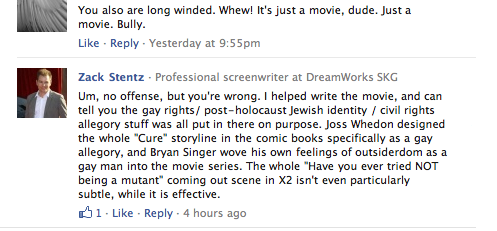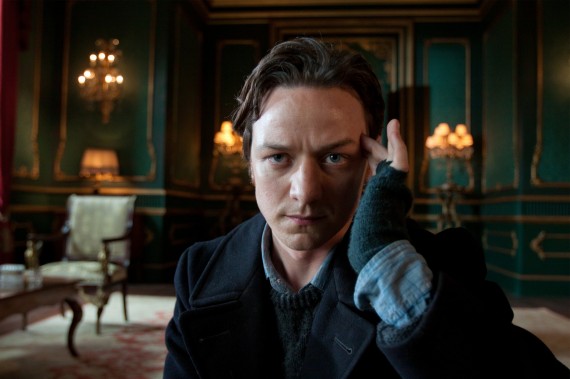You can find millions of reviews online for popular movies, so it would be futile of me to write a 'Rooksburg Reviews'- those will be saved for more obscure films and games, things you're not likely to have seen already. Instead I will be looking at some films from the viewpoint of an English teacher that can find deep symbolism in every line of Shakespeare- regardless of whether the author intended it or not.
My first choice for this is an interesting one- X-Men: First Class. It is interesting because of this:

So there we can see that there's not just one, but three themes that people have strong opinions about, in a decent-but-not-outstanding series that's ultimately about superheroes beating up supervillains. The main theme picked up on is the gay theme, as shown above; for the civil rights symbolism you're better off looking at the comics. I know the LGBT community praises the series for raising awareness, but is it really helping that much? Anyone who notices the symbolism will be called out for reading too much into the movies, as the person above Mr. Stentz did- and the writer won't always be around to correct people. Once you know the symbolism is intentional then yes, the series does a very good job of showing the various difficulties LGBT people face- but is it raising awareness if the only people that see the symbolism are those that are aware already? Those audience members that need to be made aware won't see any symbolism because they think they're just watching a comic-book movie about blowing things up. Just one small addition would have been enough to trigger in people's minds that this is all symbolic, and that's to have an actually gay character say something along the lines of 'wow, your mutant problems are exactly the same as what I'm going through'- and I wouldn't be surprised if the writers wanted to include something like that, but openly gay characters are still frowned upon by producers.

Now I've got the serious part over with, time for some fun that relies on one extremely cynical viewpoint: it's easy to say symbolism is intentional if someone's done the work for you. It makes you look like you're open-minded and performing a greater service, just because people are seeing what they want to see- after all, the gay subtext could just as easily be seen as anti-gay based on the actions of Magneto and the Hellfire club, who coincidentally are the characters most open about their 'mutations'.
To prove my point on how easy it is to find symbolism for anything, here's an interpretation of X-Men: First Class as a tale about the War on Drugs, in the height of the swinging sixties.
Please note that if you enjoy the film as it is and don't want it ruined then you may want to look away now.
(I thought this would be quite a ridiculous interpretation, but the more I looked the more I wondered if this was the actual message the writers wanted to convey- I see a lot more symbolism for drugs than I do for homosexuality... make of that what you will)
The key to understanding this interpretation, is that the severity of the mutation reflects the severity of the addiction.
First we have Shaw- powerful drug lord, and the central character to the story. He has the most powerful mutation/habit, and is in full control of it. His plan is to trigger World War III, which he hopes will create a world of mutants- people that have found a vice to relax their fears. Significant to his plans is establishing a foothold in Cuba.
His first victim is Erik/Magneto. He discovered his mutation in a Nazi laboratory, run by Shaw. Shaw offers him a piece of candy- he refuses. Shaw tries to convince him to try 'just a little' manifestation of his powers- he refuses. Eventually it takes the killing of his mother to push Erik over the edge- in his grief he becomes completely addicted to his powers, but can't bring himself to kill his supplier, who says 'we're going to have a lot of fun together'. Erik embraces his mutation, becoming completely dependant on it, and spends his life hunting down Shaw- the man that turned him into a monster. When Erik lost control of his power- nearly dying when trying to lift the sub- Xavier helped him, and took him to his rehab centre. Erik was going to leave rehab, but acknowledges he needs the help. When Erik finally confronts Shaw, he can't resist just one more tiny use of his powers- enough to send him spiralling out of control, and taking Shaw's place as drug lord much to Xavier's dismay- he becomes Xavier's failure.
 |
| Xavier still suffers migraines from his addiction |
Xavier/ Professor X, as previously mentioned, set up a rehab centre. He has first-hand experience of mutations, but now has it under control. It is implied that he started due to a poor relationship with his mother. Because he managed to control it, he wants to help others control their powers. His experience also means he can identify when others have a problem. He still suffers migraines from time to time, hence raising his hand to his head.
Raven/ Mystique has the greatest dependence on her powers. In fact she needs them to get through daily life, and she is constantly trying to mask them. She is introduced as having broken into a rich house, looking for food, and unable to conceal her power. Xavier takes her in, his first attempt at healing someone. She can't control herself, especially when tired or stressed. Erik points out it takes all her strength to hide, so she should be open about it and it will make her more relaxed- she eventually succumbs and joins Erik when he becomes Magneto. Hank hoped he could cure her dependence, but she refused.
Hank/Beast was very good at hiding his mutation- Xavier notices, to which Hank says 'you didn't ask so I didn't tell'. He is highly intelligent, and is working on a cure that will keep the power whilst hiding the superficial evidence. Unfortunately it doesn't work, and Hank becomes Beast- a creature with a short temper and entirely driven by his addiction.
 |
| Darwin's overdose |
Xavier's 'recruits': Angel works as a stripper in a nightclub, her ability always on show but unnoticed. She attempts rehab but it doesn't work for her, so she falls for Shaw's temptation. Darwin is proud of his ability and thinks he will live forever- his ability lets him 'adapt to survive'- but when Shaw comes along, he OD's on his own power. Havok was imprisoned due to his ability- he acknowledges that he's destructive when under the influence, and very self-conscious about it, but with Xavier's help he can focus himself more. Banshee is found as a teenager hanging out in a dark aquarium, and although he enjoys his ability it often makes him scream- usually through fear.
The Hellfire club: Azazel is so reliant on his ability that he now looks completely inhuman, and couldn't hide it even if he wanted to. Riptide is a quiet man in a suit, and when he uses his ability it's variable as to how potent it will be. Emma Frost looks perfectly natural, but is quite happy to demonstrate her ability in public, much to the horror of anyone watching.
So there you have it. The film is in fact about a drug lord in the 60s trying to make the whole world reliant on him, whilst those that know how much pain drugs can cause are working with the American government to try and stop him. They succeed, but only for a new drug lord to take his place, mostly due to all drug-users being labelled as criminals. Personally I see that interpretation as having much more evidence than the homosexual interpretation...
 |
| ...but then again |









